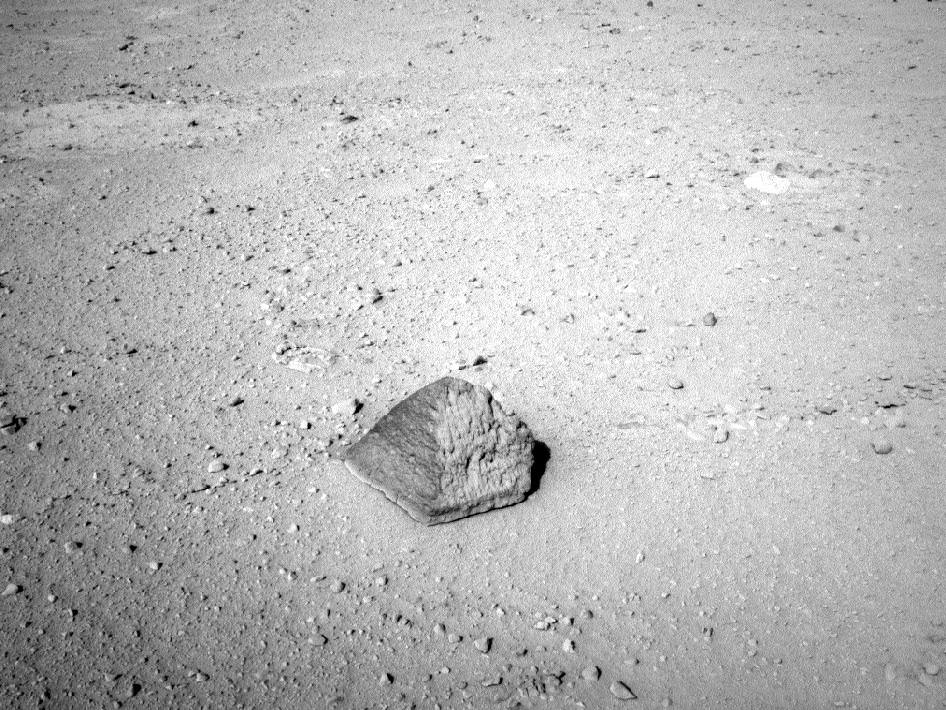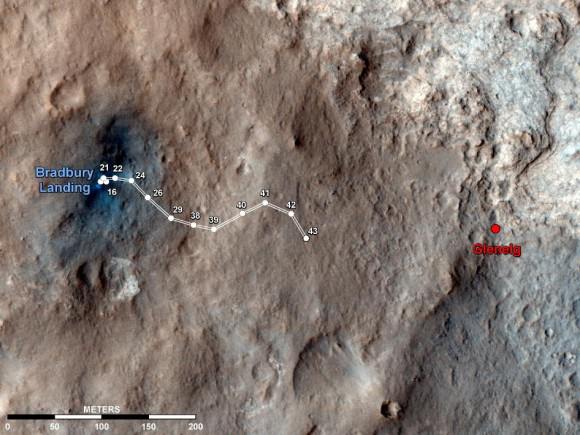The rock chosen for the first contact science investigations for the Curiosity rover. Credit: NASA/JPL-Caltech
The Mars Science Laboratory team has identified their target for the first full-up contact science investigations using all the instruments attached to the Curiosity rover’s robotic arm. And ‘target’ is the operative word here, as this rock will be shot with Curiosity’s laser to help determine it chemical makeup. Interestingly, it has an unusual pyramid shape, and it was described as a “cool-looking rock sitting out on the plains of Mars,” by MSL project scientist John Grotzinger. But the rock now has a name, and while we don’t know everything about it yet, like its namesake, this rock likely has a very interesting back story.
The rock has been dubbed “Jake Matijevic,” named for the surface operations systems engineer for all the Mars rover missions so far. But unfortunately, Matijevic passed away at age 64 just days after Curiosity touched down on Mars last month. Matijevic was one of the original technology developers for rovers on Mars — figuring out how to link the mechanics, avionics and all the systems together. He led the surface operations for the Sojourner rover in 1996, worked for years with the Spirit and Opportunity rovers, and was instrumental in getting the Curiosity rover ready for its mission.
Matijevic originally was a mathematician and he developed the Matijevic Theorem, which MSL’s John Cook described as “an obscure mathematical theorem” but others have said it was “one of the most beautiful results of recent years in commutative algebra.”
“To honor Jake and his contributions we’ve named the first rock where we’re going to do contact science after him,” said Grotzinger.
The rock named Jake is about 25 centimeters (10 inches) tall and 40 cm (16 in) wide at the base, so it’s not a very large rock, nor is it very eccentric. It likely is a shapely lump of basic basalt ejecta. It is uniform in color and is actually similar in size, shape and composition to the first rock studied by the Spirit rover over eight years ago. But being a rather ordinary rock is a good thing, said Grotzinger.
“The science team has had interest for some time to find a rock that is relatively uniform in composition to do comparisons,” between the ChemCam (the laser-zapper tool) and the Alpha Particle X-ray Spectrometer (APXS), Grotziner said, to calibrate both instruments, especially the ChemCam, which is a new version of an instrument that is on the MER rovers.
“Here we get to really test a comparison between something that is tried and true with the latest and greatest technology,” he said.
Grotziner noted that most of the terrain they are seeing so far in Gale Crater has a rather uniform surface soil with some bedrock peeking out occasionally. But darker rocks like Jake, just sitting on the surface, are not quite so common. So how did Jake get there?
“Our general consensus is that it might be a piece of secondary of impact ejecta, maybe from an impact somewhere else, maybe outside of Gale Crater,” Grotziner said, “where a rock was thrown into Gale Crater and it has just sat there for a long time. It appears to have weathered more slowly than the stuff that’s around it, so that means it’s probably a harder rock.”
So a rock blasted from a huge impact on another location on Mars ends up sitting in Gale Crater where the Curiosity rover is going to zap it with a laser.
Oh, the stories this rock will be able to tell. And hopefully the instruments on Curiosity will allow the rock to divulge its secrets.
This map shows the route driven by NASA’s Mars rover Curiosity through the 43rd Martian day, or sol, of the rover’s mission on Mars (Sept. 19, 2012). Credit: NASA/JPL-Caltech/Univ. of Arizona



I think it’s the very top of a huge buried pyrimid. Probably zaping it with the laser will “charge” it and start a chain reaction. Think I’ll use this idea in my SR story.
Or, maybe it’s just a damn rock.
it`s quite similar to piramids. Width/high ratio is 1,6 (close to Fibonacci). Intersting to know hypotesis how it was shaped.
Space_Sailor: Well, hmmmm—. I am writting a film treatment about Solar Sailing. Could you contact me about why you choose to use that identity tag? I need more input about all the possebilities.
As for that weird rock; one of the commenters’ said it was basaltic. I agree, probably the top of a basaltic column. Which means lava formed and flowed way back when. Or, at least I am assuming that. Only way for a rock to form in that shape, I would think.
Concerning nick – It was just accident. Sorry if I disappointed You.
I’m so excited! It’s like watching a really really slow paced yet riveting scene in a science fiction piece play itself out…
Such a mysterious rock with endless possibilities, just sitting there waiting to be discovered The shape looks like its been carved or formed but for it to be just sitting there,appearing to be waiting is mysterious in itself.I do believe there’s more to come though.
It’s just a rock
It is of basalt. Can it be distinguished from basalt in my garden.
Tenstripe,
I agree, mostly. Looks to me the tippy top, or bottom, of a basaltic column. Which means lava flowed way back when. Which implies all sorts of problems, being that it is in a crater. Most odd. If you trip on through the Columbia River gorge between Oregon and Washington states, morso on the Washington side, you can plainly see basaltic columns. That is the only way I can describe this rock, naturally occuring anyway. Unless you know of some other way. Please let me know what you think.
What are the odds that a rock on another planet looks like a pyramid?
so 2 days already passed. the rock was already “zapped” and still no updates from Nasa. So life or no life “zat ” is za question! why so much silence this time? I don’t care about Mars moon eclipses , I want to know the results.. like anytime soon please 🙂 !
The next rock they find will look like a face.
No doubt this rock was a surveyor marker used to layout the course of the canals first discovered at the turn of the 19th into the 20th century. The canal was never dug.